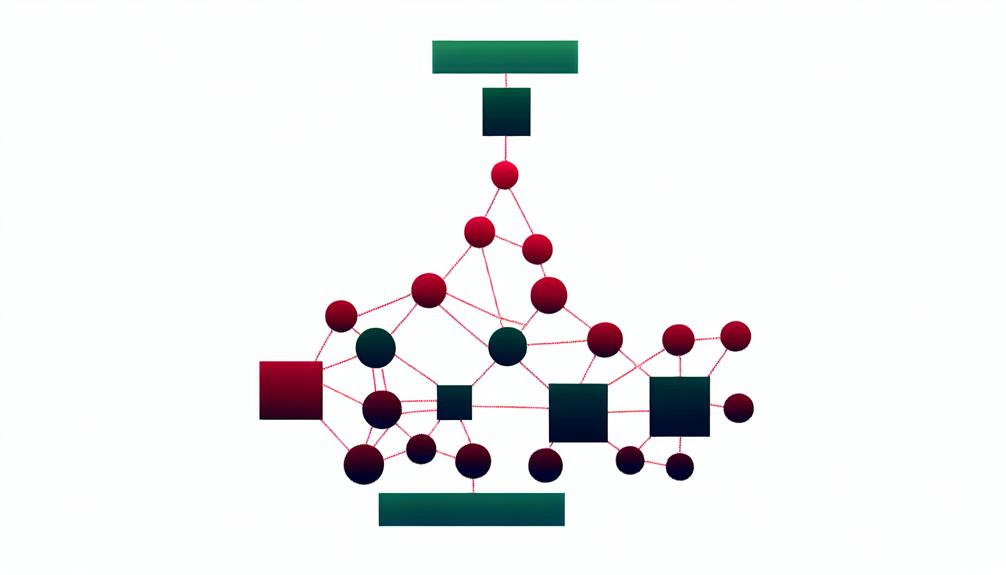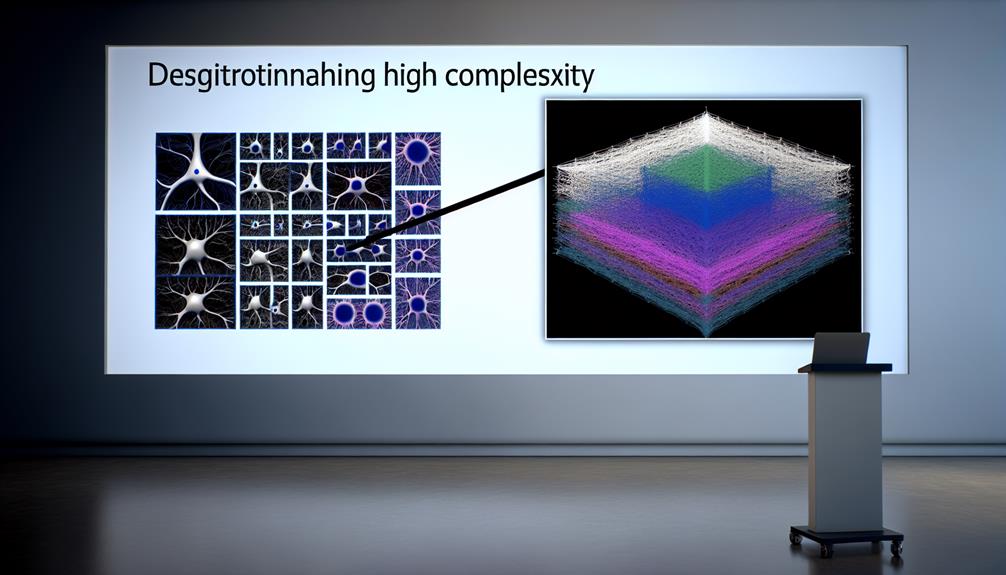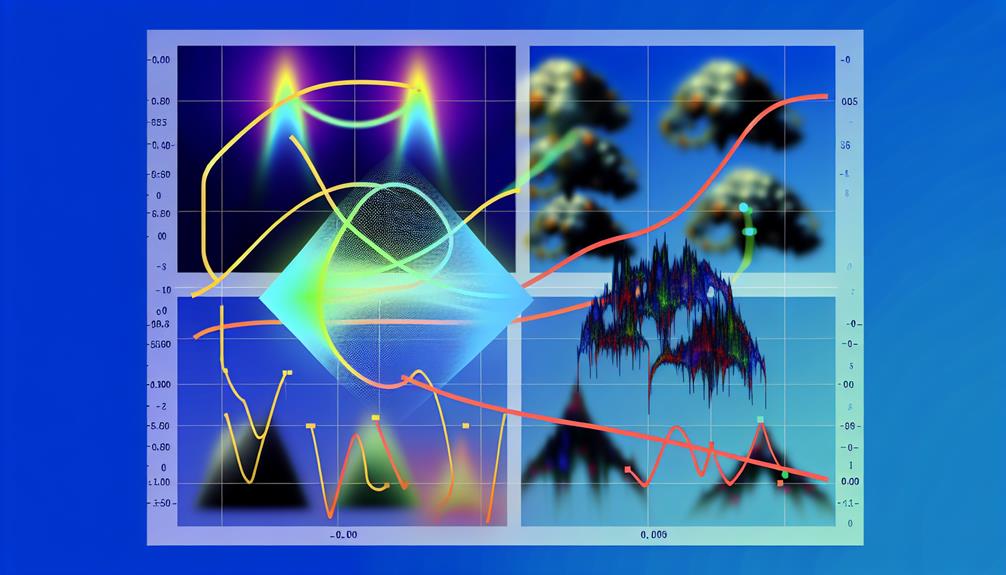Advanced machine learning models are essential for extracting insights from extensive datasets. Techniques such as deep learning neural networks mimic human brain structures to handle complex patterns. Ensemble methods like Random Forest and Gradient Boosting enhance predictive accuracy, while hierarchical clustering uncovers deep data structures. Advanced time series forecasting models like LSTM and ARIMA improve predictions. Computational neural networks, including CNNs and RNNs, are widely applicable. Other models include advanced support vector machines for efficient computation, gradient boosting machines for high accuracy, and high-dimensional data analysis with dimensionality reduction. For more detailed information about these models and how they can optimize performance and accuracy, explore further.
Key Takeaways
- Deep Learning Neural Networks: Advanced models inspired by the human brain for processing complex patterns, used in image recognition, natural language processing, and time series forecasting.
- Ensemble Methods: Techniques combining weak classifiers like Random Forest, Gradient Boosting, and AdaBoost for enhanced predictive accuracy and resilience in handling big data.
- Hierarchical Clustering: Uncovering deep structure and relationships in data, visualized by dendrograms, essential for large datasets.
- Advanced Time Series Forecasting: Models like ARIMA, SARIMA, and LSTM providing accurate predictions in finance, e-commerce, healthcare, and transportation.
- Convolutional Neural Networks (CNNs): Efficient for image classification, object detection, and face recognition tasks, used in various domains for data analysis.
Deep Learning Neural Networks
Deep learning neural networks, which draw inspiration from the human brain's structure and function, are a subset of machine learning models that excel in handling complex patterns and large datasets, making them ideal for various big data applications.
These models consist of multiple layers of interconnected nodes that process and learn from data to make predictions or classifications. The layered architecture allows deep learning neural networks to learn intricate relationships in data, enabling them to make more accurate predictions.
Applications of these models include image recognition, natural language processing, and time series forecasting. They are particularly useful in big data analytics where the sheer volume and complexity of data pose significant challenges to traditional machine learning algorithms.
Neural networks are designed to automatically extract features and abstractions from data, making them well-suited for tasks where patterns are not well-defined or are difficult to program manually. By leveraging the power of deep learning neural networks, businesses and organizations can derive actionable insights and value from their big data, leading to improved decision-making and competitiveness.
Ensemble Methods for Big Data
When dealing with big data, ensemble methods offer a powerful approach to enhance predictive accuracy by combining multiple machine learning models. By aggregating the strengths of diverse models, ensemble methods can effectively reduce overfitting, handle high-dimensional data, and provide robust performance.
Techniques like Random Forest, Gradient Boosting, and AdaBoost are among the widely used ensemble methods leveraged in various applications for improved predictive power.
Combining Weak Classifiers
Combining Weak Classifiers
Individual weak classifiers can achieve remarkable predictive improvements by leveraging the power of ensemble methods, particularly in complex big data applications. By combining multiple weak models, ensemble methods can reduce overfitting and boost overall accuracy. Techniques like Random Forest, Gradient Boosting, and AdaBoost are popular ensemble methods utilized in big data analysis.
Comparative Analysis of Ensemble Methods
| Method | Key Features | Advantages |
|---|---|---|
| Random Forest | Combines multiple trees, fully grown trees | Robust to outliers, parallelizable |
| Gradient Boosting | Sequential learning, iterative improvement | Handles missing values, robust to noise |
| AdaBoost | Iterative learning, stumps combined | Robust to varied importance, fast convergence |
These ensemble methods effectively harness the diversity of weak classifiers to offer robust solutions for big data problems across various industries. By aggregating predictions from multiple models, they can handle complex relationships and patterns that individual models may struggle with. As the core idea behind ensemble learning is to combine multiple weak hypotheses to form a strong one, it proves especially effective in handling large datasets with numerous features.
Enhancing Predictive Accuracy
Ensemble methods like Random Forest, Gradient Boosting, and AdaBoost prove essential for enhancing predictive accuracy in big data scenarios by combining multiple weak learners to create a robust predictive model.
These ensemble methods leverage diverse perspectives and mitigate overfitting to produce more reliable predictions. Here are some key benefits:
- Combining Weak Learners:
- Ensemble methods create a strong predictive model by aggregating the predictions of multiple less powerful learners.
- Improved Accuracy:
- Methods like Gradient Boosting adjust coefficients sequentially to enhance predictive precision.
- Emphasizing Misclassified Data:
- AdaBoost focuses on highlighting misclassified data points to improve overall model accuracy.
- Robustness:
- Ensemble methods enhance predictive accuracy and resilience in handling big data challenges.
These techniques are vital for big data applications where accuracy is paramount, such as fraud detection, risk modeling, and personalized customer experiences.
Hierarchical Clustering for Insights

Hierarchical clustering is a versatile and powerful technique in data mining that uncovers the deep structure and relationships between data points by creating a hierarchy of clusters. This flexible approach can be employed in two primary ways: agglomerative and divisive.
Agglomerative hierarchical clustering is a bottom-up strategy, where individual data points are initially treated as separate clusters. These clusters are then iteratively merged based on similarity until a single cluster containing all data points is formed.
On the other hand, divisive hierarchical clustering follows a top-down approach, where all data points are initially grouped into a single cluster, and subsequent splits create smaller sub-clusters based on dissimilarity.
Hierarchical clustering is particularly advantageous for big data analysis as it does not require the number of clusters to be specified beforehand. The results are typically visualized using dendrograms, providing a clear and interpretable representation of the cluster structure.
This technique is essential for revealing relationships within large datasets, making it an indispensable tool in data science. By incorporating hierarchical clustering into a data analysis workflow, insights can be drawn more effectively, enabling informed decision-making across various domains such as customer segmentation, crime analysis, and healthcare diagnosis.
Advanced Time Series Forecasting
While uncovering insights through hierarchical clustering is essential, the domain of advanced time series forecasting offers a distinct avenue for exploration, leveraging models such as ARIMA, SARIMA, and LSTM to predict future values based on chronological patterns.
These models are designed to handle complex data structures and enhance forecasting accuracy.
Key Features of Advanced Time Series Forecasting
- Accurate Predictions: Advanced models can capture and account for non-stationarity, trends, and seasonality, leading to improved predictions.
- Model Variations: Models like ARIMA, SARIMA, and Exponential Smoothing cater to different types of time series data.
- LSTM and Deep Learning: Long Short-Term Memory (LSTM) models and other deep learning techniques offer significant improvements in modeling complex temporal relationships.
- Domain Applications: Time series forecasting is vital in industries like finance, e-commerce, healthcare, and transportation for decision-making and planning.
Computational Neural Networks

Computational neural networks are advanced machine learning models designed to mimic the human brain's neural networks, proving highly effective in handling big data for complex tasks. These interconnected nodes process and learn from data to make predictions and classifications, making them ideal for tasks such as image recognition, natural language processing, and speech recognition.
The ability of these models to handle vast amounts of data leverages parallel processing and distributed computing, allowing them to excel in big data analysis.
Deep learning models, such as Convolutional Neural Networks (CNNs) and Recurrent Neural Networks (RNNs), are examples of computational neural networks used for big data analysis. CNNs are particularly effective in image recognition, while RNNs are well-suited for sequential data like time series analysis.
This versatility has led to widespread use in various domains, from healthcare to finance and marketing. By harnessing the power of neural networks, data analysts can uncover hidden insights and make more accurate predictions, ultimately driving business growth and improvements.
Advanced Support Vector Machines
In advanced support vector machines, we focus on optimizing hyperplane separation through both linear and non-linear classification methods.
Non-linear classification is enabled by the kernel trick, which transforms data into higher-dimensional spaces to facilitate linear separation.
Soft margin training allows SVMs to accommodate data points that are not perfectly linearly separable.
Non-Linear Classification
Advanced Support Vector Machines (SVMs) leverage kernel functions to transform data into higher-dimensional spaces, effectively handling complex non-linear classification tasks and achieving high accuracy through maximized margins between classes.
Key features of SVMs include:
- Mapping High-Dimensional Data: SVMs map data into higher-dimensional spaces using kernel functions, allowing for effective handling of complex non-linear relationships.
- Efficient Computation: The kernel trick enables SVMs to efficiently compute with high-dimensional data, making them suitable for large-scale applications.
- Versatility of Kernel Functions: SVMs offer a range of kernel functions, including linear, polynomial, and radial basis functions, to suit diverse machine learning tasks.
- Applications in Image Recognition and Bioinformatics: SVMs excel in image recognition and bioinformatics due to their ability to handle varied data types and achieve high accuracy.
Hyperplane Optimization
Hyperplane Optimization in Advanced Support Vector Machines
By focusing on the hyperplane that yields the maximum margin between classes in high-dimensional spaces, Advanced Support Vector Machines (SVMs) achieve the best classification results. This optimization process involves finding the hyperplane that separates classes with the largest gap possible while ensuring that support vectors effectively define the decision boundary. The objective is to minimize the classification error while maximizing the margin.
Key Features of Hyperplane Optimization in SVMs
| Feature | Description |
|---|---|
| High-Dimensional Spaces | SVMs map data to higher dimensions to enhance separability, particularly in scenarios where data are not linearly separable. |
| Classification Error | The optimization process seeks to minimize classification errors by placing the decision boundary such that misclassifications are reduced. |
| Kernel Tricks | Techniques like kernel functions are employed to transform data into higher dimensions, improving classification by maximizing the margin and minimizing errors. |
Hyperplane optimization is vital in SVMs for efficient classification of big data with complex patterns and high-dimensional feature spaces. By exploiting these advanced techniques, SVMs provide highly accurate and robust classification results.
Soft Margin Training
To improve the accuracy of Support Vector Machine classification models, Soft Margin Training is engineered to tolerate a few misclassification errors, ensuring a more versatile and robust decision boundary by striking a balance between maximizing the margin and minimizing errors.
Key Benefits and Usage:
- Handling Noise and Overfitting: Soft Margin Training allows for some misclassification errors, making it particularly useful for handling noisy or overlapping data where a hard margin may not be feasible.
- Balanced Trade-off: It helps prevent overfitting by balancing the maximization of the margin with the minimization of classification errors.
- Practicality for Real World Applications: Soft Margin SVM is essential for handling real-world scenarios where perfect separation is not possible.
- Customizable via the Regularization Parameter: The parameter C in the Soft Margin SVM model controls the trade-off between margin width and classification error.
Gradient Boosting Machines

Gradient Boosting Machines, a powerful ensemble learning technique, leverage sequential model building and gradient descent principles to enhance predictive accuracy and effectively handle complex patterns and large datasets. This method combines multiple weak learners into a strong learner, known for delivering high accuracy in predictions.
By building trees sequentially, Gradient Boosting Machines correct errors made by previous models, reducing both bias and variance in the final prediction. Widely recognized for their effectiveness in Kaggle competitions, these models require meticulous tuning of hyperparameters to achieve peak performance.
This versatility has led to their widespread use across various industries, where predictive power is paramount. The ability to efficiently manage high-dimensional datasets and handle intricate patterns has solidified GBMs as a go-to choice for advanced machine learning tasks, particularly those demanding high accuracy and precise modeling capabilities.
High-Dimensional Data Analysis
High-dimensional data analysis necessitates techniques to manage the complexities of large datasets, particularly through dimensionality reduction methods.
Efficient visualization and clustering algorithms are vital for uncovering patterns and relationships in high-dimensional data.
Effective approaches to these challenges are essential for successfully analyzing and modeling big data.
Dimensionality Reduction Techniques
Dimensionality reduction techniques, like PCA and t-SNE, are important tools for high-dimensional data analysis as they effectively reduce complex data structures into lower dimensions while retaining important patterns and relationships, thereby enhancing computational efficiency and improving data visualization and understanding.
The significance of dimensionality reduction techniques can be summarized as follows:
- Preservation of Patterns and Relationships: These techniques ensure that essential information in the data is retained while reducing dimensions.
- Improved Computational Efficiency: Dimensionality reduction notably speeds up the training process for machine learning models by reducing the number of features.
- Enhanced Data Visualization: Lower dimensions enable better data visualization, making it easier to identify patterns and relationships.
- Improved Model Performance: By reducing the number of features, machine learning models can perform better on large datasets with complex structures.
Dimensionality reduction techniques like PCA and t-SNE have numerous applications in various fields, including computer security, medical research, and natural language processing. These techniques are vital for handling big data, and their implementations have had a significant impact on various industries.
Big Data Visualization
Big data visualization techniques like t-SNE and PCA greatly enable the analysis of high-dimensional datasets by decreasing complexity while preserving valuable information for more effective pattern recognition and relationship analysis. These methods are particularly important because they allow for the identification of trends, clusters, and relationships that might be lost in the complexity of high-dimensional data.
t-SNE, in particular, is exceptionally effective for visualizing clusters and patterns in high-dimensional data by trying to preserve the local structure of the data. PCA, on the other hand, reduces dimensionality by transforming high-dimensional data into lower-dimensional representations called principal components. These components are uncorrelated and ordered based on their variance, making it easier to visualize and understand the underlying structures of the data.
Tools like Matplotlib and Seaborn are commonly used for big data visualization, allowing data scientists to represent complex information in visually appealing and informative ways.
High-Dimensional Clustering
Clustering algorithms are necessary for analyzing and interpreting complex datasets with a large number of features or dimensions. High-dimensional clustering plays a pivotal role in data analysis, particularly in the context of big data.
Here are some key aspects of high-dimensional clustering:
- Essential for Complex Datasets: High-dimensional clustering is vital for making sense of datasets with numerous features or dimensions, commonly encountered in areas like bioinformatics and customer segmentation.
- Common Algorithms: DBSCAN and K-means are popular clustering algorithms used for high-dimensional data analysis.
- Hidden Patterns: High-dimensional clustering helps uncover hidden patterns and structures within data, leading to better decision-making.
- Multifaceted Applications: It is applied in various domains, including image recognition, genomics, and e-commerce customer segmentation.
Machine Learning Optimization Techniques

Machine learning enhancement techniques are an essential component of improving model performance and generalizing well on unseen data, as they employ various methodologies to adjust hyperparameters, select features, and modify model architectures effectively. These techniques are vital for handling big data, ensuring that models converge faster and provide better accuracy.
Enhancement techniques can be categorized into multiple types:
| Enhancement Technique | Description | Function |
|---|---|---|
| Gradient Descent | Adjusts learning rate iteratively | Minimizes loss function |
| Stochastic Gradient Descent | Uses random data samples | Updates weights for each sample |
| Adam | Combines momentum and RMSprop | Adaptive learning rate |
| RMSprop | Normalizes gradient by magnitude | Escapes saddle points |
| Batch Normalization | Normalizes layer inputs | Improves convergence |
Additionally, methods like early stopping, regularization, and feature selection help prevent overfitting and improve the generalization of machine learning models. Effective hyperparameter tuning and model architecture adjustments are also essential for achieving best outcomes.
Advanced Deep Learning Architectures
Sophisticated deep learning architectures such as Convolutional Neural Networks (CNNs) and Recurrent Neural Networks (RNNs) are specifically designed for complex tasks like image recognition, sequential data analysis, and language understanding. These advanced models have revolutionized numerous domains by leveraging their unique capabilities:
- Image Recognition with CNNs: CNNs excel in tasks like image classification and object detection by automatically learning hierarchical patterns from data.
- Sequential Data Analysis with RNNs: RNNs are powerful for tasks like natural language processing and time series forecasting due to their ability to retain sequential information.
- Transformers for Language Understanding: Transformer models, such as the popular BERT and GPT series, have revolutionized tasks like language understanding and generation by leveraging self-attention mechanisms.
- Domain-Specific Applications: Advanced deep learning architectures often require significant computational resources and data for training, but they offer state-of-the-art performance in various domains.
These cutting-edge architectures are essential for processing and analyzing large, complex datasets effectively, providing valuable insights and precise predictions.
Frequently Asked Questions
Which Machine Learning Algorithm Is Best for Large Dataset?
For large datasets, gradient boosting machines and random forests are effective due to their scalability and ability to handle high dimensionality. They outperform neural networks, which require substantial computational resources, in balancing accuracy and efficiency.
Can Machine Learning Handle Big Data?
Machine learning effectively handles big data by overcoming scalability challenges through efficient data preprocessing, feature engineering, and model selection. Hyperparameter tuning and thorough performance evaluation guarantee optimized results, even with massive datasets.
What Are the 10 Machine Learning Algorithms Every Data Scientist Know?
"Every data scientist should know algorithms like Decision Trees, Support Vector Machines, Neural Networks, Clustering, Dimensionality Reduction, Regression Models, and those for Time Series Analysis, Natural Language Processing, Computer Vision, Anomaly Detection, and Reinforcement Learning."
What Are the 4 Types of Machine Learning Algorithms?
The four types of machine learning algorithms are supervised, unsupervised, reinforcement, and semi-supervised learning. Supervised learning uses labeled data, while unsupervised learning finds patterns without labels.









